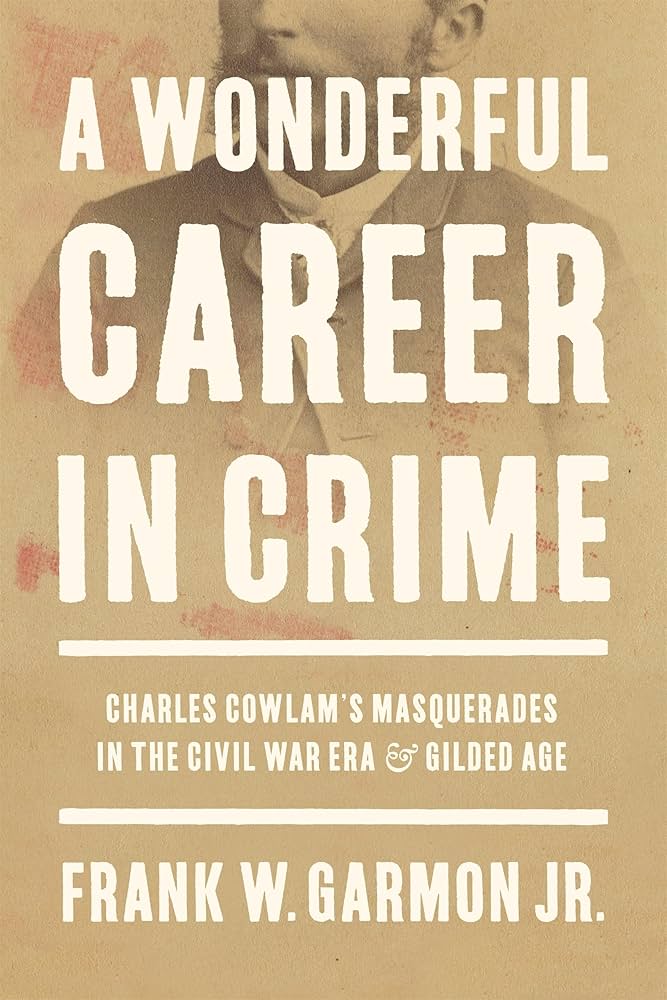Book Review: A Wonderful Career in Crime: Charles Cowlam’s Masquerades in the Civil War Era & Gilded Age
 A Wonderful Career in Crime: Charles Cowlam’s Masquerades in the Civil War Era & Gilded Age. By Frank W. Garmon Jr. Baton Rouge: Louisiana State University Press, 2024. Hardcover, 241 pp. $45.00.
A Wonderful Career in Crime: Charles Cowlam’s Masquerades in the Civil War Era & Gilded Age. By Frank W. Garmon Jr. Baton Rouge: Louisiana State University Press, 2024. Hardcover, 241 pp. $45.00.
Reviewed by Aaron Stoyack
Charles Cowlam went by many names and lived an eventful life, though few during his day recognized it. He was the only man pardoned by both Abraham Lincoln and Jefferson Davis, served as a detective in Washington after Lincoln’s assassination, performed police work for the IRS, British, and Canadian agencies, ran for office in Florida, and landed in the National Home for Disabled Volunteer Soldiers. Cowlam gained none of these distinctions by his own merit, but rather through systematically relocating and lying about his past. Along the way, the lifelong criminal perpetrated plots to defraud honest citizens for his personal enrichment.
Author Frank W. Garmon Jr. answers how the miscreant pulled off his incessant schemes through a short, page-turning narrative. Principally, Cowlam spun his lies during the optimal time period to do so. Early in the nation’s history, most would be cautious, if not outright distrustful, toward new arrivals. By the 1900s, more stringent methods of identification came into play. However, the middle of the 19th century saw migration into urban areas and the frontier advancing at an unforeseen pace, which resumed in the postwar era. One’s qualifications and previous dealings were often difficult or impossible to verify, and a shrewd shyster could leverage half-truths to enter respectable occupations and high society. Cowlam succeeded in crafting stories that were difficult to disprove, always emphasizing a sense of urgency to explain why he was the man for the job.
Garmon is an assistant professor of American Studies at Christopher Newport University, and many of his other publications discuss economics and political power in the early republic. The author seamlessly transitions to the study of how a convict convincingly subverted societal norms and situated himself into positions of civic, professional, and political importance.
Garmon typifies Cowlam as “the ‘exceptional normal,’ an outlier that stands in as representative for a group of individuals whose experiences might be otherwise lost in the historical record” (6). Doubtlessly many others during the 19th century moved elsewhere and assumed a new identity, but their cases are elusive by nature. This book adds to a growing body of scholarship on “confidence men” who advance their reputations through deceit. The term has long been used in analyses of literature, but biographies of historical confidence men have only emerged in earnest since the late 1990s.
Cowlam’s cloak-and-dagger behaviors left him just as difficult to track through history as he was during his lifetime. Until Garmon’s work, there has been no substantive examination of Cowlam, and only his dual pardons brought any notoriety to his name. A detractor published an exposé during Cowlam’s lifetime, yet the piece contained several errors. This scarcity of secondary sources obliged the author to comb through countless primary accounts to chart Cowlam’s escapades. Garmon provides brief background information to explain the spaces in which Cowlam operated. These introductions, while short, are meticulously researched and cited.
Chapters begin with a one or two-page summary of Cowlam’s deceit in the given timeframe before a subheader resumes the chronological narrative. Readers expecting a sequential order of events will quickly adapt as each introduction subtly poses the question: How did this conman sell this lie so convincingly?
Civil War buffs should not expect to learn a wealth of new information about the conflict from this work. It offers some insight into spycraft, prisons, and the treatment of veterans, and is a unique break from biographies of military and political men of renown. Cowlam’s adventures continue through Reconstruction into the Gilded Age with remarkable connections to familiar figures. The swindler adopts many more roles than described in this review, and half the excitement comes from itching to learn the next triumph or calamity his efforts bring. Whether rooting for or against him, A Wonderful Career in Crime offers an engaging tale of the turbulent life of a fraudster that, at times, seems almost unbelievable.
Aaron Stoyack is a public historian, museum specialist and writer employed as a Park Ranger at Pamplin Historical Park. He graduated Summa Cum Laude from West Chester University with a B.A. in History and a Minor in Museum Studies. Aaron has served on local commissions and presented at regional and national public history and education conferences. He enjoys researching and interpreting all aspects of history, from local to global in scale.
